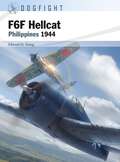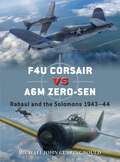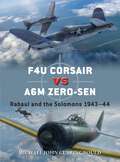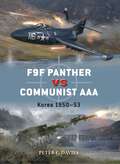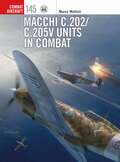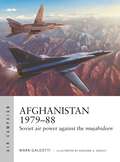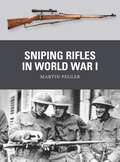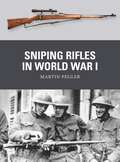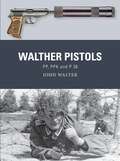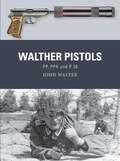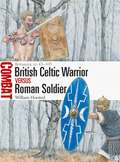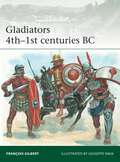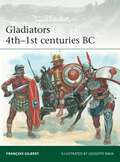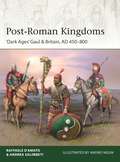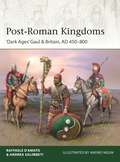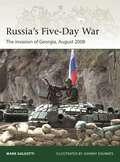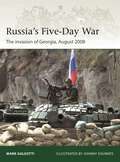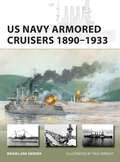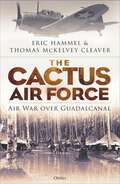- Table View
- List View
F6F Hellcat: Philippines 1944 (Dogfight #5)
by Edward M. YoungUsing maps, contemporary photographs, and new artwork, this book examines the Hellcat and the naval aviators who flew them.Joining combat in the Pacific in late 1943, the Hellcat squadrons soon demonstrated their ascendency over their Japanese opponents, culminating in the great "Marianas Turkey Shoot" during the Battle of the Philippine Sea in June 1944. The fighter proved to be a dream for pilots to fly, allowing both novice and veteran Naval Aviators alike to prevail in largescale aerial combats. From October 1944 to January 1945, the Fast Carriers supported General MacArthur's invasion of the Philippines.Featuring specially commissioned armament views and battlescenes, this book covers the key role played by Naval Aviators flying the Hellcat into action during the Fast Carrier Task Force's strikes against the Philippines in September and October 1944. Using maps, contemporary photographs, and technical diagrams, the volume examines the highly effective tactics used to prevail against large enemy formations, and reveals the training that underpinned the success enjoyed by the Naval Aviators and their Hellcats. The key combat actions are vividly described through 3D ribbon diagrams providing a step-by-step depiction of the main dogfights featured in the book, as well as action reports, both from previously unknown pilots and from more famous Hellcat aces.
F6F Hellcat: Philippines 1944 (Dogfight)
by Edward M. YoungUsing maps, contemporary photographs, and new artwork, this book examines the Hellcat and the naval aviators who flew them.Joining combat in the Pacific in late 1943, the Hellcat squadrons soon demonstrated their ascendency over their Japanese opponents, culminating in the great "Marianas Turkey Shoot" during the Battle of the Philippine Sea in June 1944. The fighter proved to be a dream for pilots to fly, allowing both novice and veteran Naval Aviators alike to prevail in largescale aerial combats. From October 1944 to January 1945, the Fast Carriers supported General MacArthur's invasion of the Philippines.Featuring specially commissioned armament views and battlescenes, this book covers the key role played by Naval Aviators flying the Hellcat into action during the Fast Carrier Task Force's strikes against the Philippines in September and October 1944. Using maps, contemporary photographs, and technical diagrams, the volume examines the highly effective tactics used to prevail against large enemy formations, and reveals the training that underpinned the success enjoyed by the Naval Aviators and their Hellcats. The key combat actions are vividly described through 3D ribbon diagrams providing a step-by-step depiction of the main dogfights featured in the book, as well as action reports, both from previously unknown pilots and from more famous Hellcat aces.
F4U Corsair versus A6M Zero-sen: Rabaul and the Solomons 1943–44 (Duel)
by Michael John ClaringbouldThe aerial clashes between the iconic Corsair and Zero-sen translated into a contest of speed and altitude for the former, versus the latter's outstanding agility and range.Whilst the F4U Corsair eventually proved to be a superior fighter in Pacific operations, its introduction into combat in this theatre initially demonstrated its weaknesses. Indeed, the 'Saint Valentine's Day Massacre' debacle showcased exemplary Zero-sen fighter tactics, and American losses were of sufficient magnitude that further daylight missions toward Bougainville were discontinued until Allied fighter tactics could be improved. As a result, for the next two months the Corsair's combat results were much subdued. Indeed, the F4U only became a superb fighter when both its pilots and their commanders worked out how to deploy the gull-wing design effectively. Optimum circumstances for effective engagement did not always occur, and the Zero-sen remained effective against the Corsair until February 1944 in the South Pacific, after which all IJNAF fighter units vacated Rabaul. This book closely examines these two different fighters in the Solomons/Rabaul theatre, and the unique geographic conditions which shaped their deployment and effectiveness. It contains rare photographs and digital artwork that accurately showcases and aligns combats of both types in-theatre with unprecedented accuracy. Both sides vastly over-claimed. With full access to IJNAF and US Navy/US Marine Corps records, these numbers will be presented accurately.
F4U Corsair versus A6M Zero-sen: Rabaul and the Solomons 1943–44 (Duel)
by Michael John ClaringbouldThe aerial clashes between the iconic Corsair and Zero-sen translated into a contest of speed and altitude for the former, versus the latter's outstanding agility and range.Whilst the F4U Corsair eventually proved to be a superior fighter in Pacific operations, its introduction into combat in this theatre initially demonstrated its weaknesses. Indeed, the 'Saint Valentine's Day Massacre' debacle showcased exemplary Zero-sen fighter tactics, and American losses were of sufficient magnitude that further daylight missions toward Bougainville were discontinued until Allied fighter tactics could be improved. As a result, for the next two months the Corsair's combat results were much subdued. Indeed, the F4U only became a superb fighter when both its pilots and their commanders worked out how to deploy the gull-wing design effectively. Optimum circumstances for effective engagement did not always occur, and the Zero-sen remained effective against the Corsair until February 1944 in the South Pacific, after which all IJNAF fighter units vacated Rabaul. This book closely examines these two different fighters in the Solomons/Rabaul theatre, and the unique geographic conditions which shaped their deployment and effectiveness. It contains rare photographs and digital artwork that accurately showcases and aligns combats of both types in-theatre with unprecedented accuracy. Both sides vastly over-claimed. With full access to IJNAF and US Navy/US Marine Corps records, these numbers will be presented accurately.
F9F Panther vs Communist AAA: Korea 1950–53 (Duel)
by Peter E. DaviesA detailed look at the deadly battle between US Navy F9F Panther jet fighter-bombers and communist anti-aircraft artillery (AAA) defenses that proliferated throughout the Korean War.The F9F Panther was one of the many fighters converted for ground-attack duties, following an established US tradition. Originally designed as a jet fighter, in April 1951 it became the first jet to launch from a carrier with bombs loaded, using them to destroy a crucial railway bridge at Songjin. The Panther's four 20 mm guns were considered to be very effective for flak suppression and these aircraft were used as escorts for propeller-driven AD Skyraider and F4U Corsair attack aircraft. However, later in 1951, flak damage to Panthers increased as the Chinese established better AAA weapons to defend key transport routes. The communist AAA crews had heavy guns of 37 mm caliber and above. Gunners could use optical height finders, predictors and in many cases radar control. They learned to conceal their weapons in civilian buildings, use wires to bring aircraft down, and set up false targets as "flak traps." Both opponents' tactics and gunnery are explored in depth in this study of the F9F Panthers and of their adversaries. Containing full-color illustrations including cockpit scenes and armament views, this innovative volume also includes a detailed analysis of the US Navy Panthers' loss rates and their causes.
F9F Panther vs Communist AAA: Korea 1950–53 (Duel)
by Peter E. DaviesA detailed look at the deadly battle between US Navy F9F Panther jet fighter-bombers and communist anti-aircraft artillery (AAA) defenses that proliferated throughout the Korean War.The F9F Panther was one of the many fighters converted for ground-attack duties, following an established US tradition. Originally designed as a jet fighter, in April 1951 it became the first jet to launch from a carrier with bombs loaded, using them to destroy a crucial railway bridge at Songjin. The Panther's four 20 mm guns were considered to be very effective for flak suppression and these aircraft were used as escorts for propeller-driven AD Skyraider and F4U Corsair attack aircraft. However, later in 1951, flak damage to Panthers increased as the Chinese established better AAA weapons to defend key transport routes. The communist AAA crews had heavy guns of 37 mm caliber and above. Gunners could use optical height finders, predictors and in many cases radar control. They learned to conceal their weapons in civilian buildings, use wires to bring aircraft down, and set up false targets as "flak traps." Both opponents' tactics and gunnery are explored in depth in this study of the F9F Panthers and of their adversaries. Containing full-color illustrations including cockpit scenes and armament views, this innovative volume also includes a detailed analysis of the US Navy Panthers' loss rates and their causes.
Macchi C.202/C.205V Units in Combat (Combat Aircraft)
by Marco MattioliA study of the Macchi Folgore and Veltro, the most successful Italian fighters in World War II. With specially commissioned profiles, the book examines how these fighters were conceived, their performance and the fascinating stories of their pilots.Italian fighters, such as the Fiat G.50 and Macchi C.200, had always struggled with their straight-line speed and restricted armament when engaging their Allied counterparts. To solve these problems, Macchi initially designed the C.202 Folgore using German engines, which contributed to create a faster aircraft, with a superior rate of climb and reachable altitude. Folgore's success in various North African engagements then paved the way for the development of Macchi's most successful fighter, the C.205V Veltro, which managed to combine increased speed and increased power. Packed with specially commissioned artwork and original photos, and written by Italian military aviation specialist Marco Mattioli, this fascinating book explores how the premier Italian fighter of the war came to life and the historical circumstances that prevented it from becoming one of the most dreaded aircraft in the Mediterranean.
Macchi C.202/C.205V Units in Combat (Combat Aircraft)
by Marco MattioliA study of the Macchi Folgore and Veltro, the most successful Italian fighters in World War II. With specially commissioned profiles, the book examines how these fighters were conceived, their performance and the fascinating stories of their pilots.Italian fighters, such as the Fiat G.50 and Macchi C.200, had always struggled with their straight-line speed and restricted armament when engaging their Allied counterparts. To solve these problems, Macchi initially designed the C.202 Folgore using German engines, which contributed to create a faster aircraft, with a superior rate of climb and reachable altitude. Folgore's success in various North African engagements then paved the way for the development of Macchi's most successful fighter, the C.205V Veltro, which managed to combine increased speed and increased power. Packed with specially commissioned artwork and original photos, and written by Italian military aviation specialist Marco Mattioli, this fascinating book explores how the premier Italian fighter of the war came to life and the historical circumstances that prevented it from becoming one of the most dreaded aircraft in the Mediterranean.
Afghanistan 1979–88: Soviet air power against the mujahideen (Air Campaign #35)
by Mark GaleottiThe first English-language book to examine the crucial part air power played in the Soviet-Afghan War.The Soviet Union's invasion of Afghanistan was fought as much in the air as on the ground. From the high-level bombing raids that blasted rebel-held mountain valleys, to the Mi-24 helicopter gunships and Su-25 jets that accompanied every substantial army operation, Soviet control of the air was a crucial battlefield asset. Vital to every aspect of its operations, Mi-8 helicopters ferried supplies to remote mountain-top observation points and took the bodies of fallen soldiers on their last journey home in An12 'Black Tulips'. But this was not a wholly one-sided conflict. Even before the Afghan rebels began to acquire man-portable surface-to-air missiles such as the controversial US 'Stinger,' they aggressively and imaginatively adapted. They learnt new techniques of camouflage and deception, set up ambushes against low-level attacks, and even launched daring raids on airbases to destroy aircraft on the ground.Featuring information previously unknown in the West, such as the Soviets' combat-testing of Yak-38 'Forger' naval jump jets, Soviet-expert Mark Galeotti examines the rebel, Kabul government and the Soviet operation in Afghanistan, drawing deeply on Western and Russian sources, and including after-action analyses from the Soviet military. Using maps, battlescenes and detailed 'Bird's Eye Views', he paints a comprehensive picture of the air war and describes how, arguably, it was Soviet air power that made the difference between defeat for Moscow and the subsequent stalemate that they decided to disengage from.
Afghanistan 1979–88: Soviet air power against the mujahideen (Air Campaign)
by Mark GaleottiThe first English-language book to examine the crucial part air power played in the Soviet-Afghan War.The Soviet Union's invasion of Afghanistan was fought as much in the air as on the ground. From the high-level bombing raids that blasted rebel-held mountain valleys, to the Mi-24 helicopter gunships and Su-25 jets that accompanied every substantial army operation, Soviet control of the air was a crucial battlefield asset. Vital to every aspect of its operations, Mi-8 helicopters ferried supplies to remote mountain-top observation points and took the bodies of fallen soldiers on their last journey home in An12 'Black Tulips'. But this was not a wholly one-sided conflict. Even before the Afghan rebels began to acquire man-portable surface-to-air missiles such as the controversial US 'Stinger,' they aggressively and imaginatively adapted. They learnt new techniques of camouflage and deception, set up ambushes against low-level attacks, and even launched daring raids on airbases to destroy aircraft on the ground.Featuring information previously unknown in the West, such as the Soviets' combat-testing of Yak-38 'Forger' naval jump jets, Soviet-expert Mark Galeotti examines the rebel, Kabul government and the Soviet operation in Afghanistan, drawing deeply on Western and Russian sources, and including after-action analyses from the Soviet military. Using maps, battlescenes and detailed 'Bird's Eye Views', he paints a comprehensive picture of the air war and describes how, arguably, it was Soviet air power that made the difference between defeat for Moscow and the subsequent stalemate that they decided to disengage from.
Sniping Rifles in World War I (Weapon)
by Martin PeglerWhile Germany and Austria-Hungary were well-equipped with sniping rifles in 1914, their Allied opponents were not. This highly illustrated volume tells the inside story of the rifles carried by snipers of all the major powers during World War I.Although military sharpshooting had existed since the 18th century, in 1914 only the German and Austro-Hungarian armies fielded trained snipers armed with scoped rifles. Thus upon the outbreak of World War I, the Allied armies found themselves on the receiving end of a shooting war to which they had no means of response. Only the Canadians brought a dedicated sniping rifle into the trenches, but in small numbers. For the British, although production of a suitable rifle and scope were settled on quickly, the establishment of sniper training was difficult and its success was mostly due to the efforts of a handful of dedicated officers. The French eventually introduced a competent scoped rifle and a sniper training system, as did the Italians. Entering the war in 1917, the Americans experienced rifle shortages but were able to build on their pre-1914 efforts to find a suitable sniping weapon. The country that suffered most grievously was Russia; Russian troops fielded no snipers at all and suffered accordingly. Featuring full-colour artwork, carefully chosen archive images and photographs of the sniping rifles and accessories used in the trenches, this is the inside story of the rifles carried by snipers of all the major powers during World War I.
Sniping Rifles in World War I (Weapon)
by Martin PeglerWhile Germany and Austria-Hungary were well-equipped with sniping rifles in 1914, their Allied opponents were not. This highly illustrated volume tells the inside story of the rifles carried by snipers of all the major powers during World War I.Although military sharpshooting had existed since the 18th century, in 1914 only the German and Austro-Hungarian armies fielded trained snipers armed with scoped rifles. Thus upon the outbreak of World War I, the Allied armies found themselves on the receiving end of a shooting war to which they had no means of response. Only the Canadians brought a dedicated sniping rifle into the trenches, but in small numbers. For the British, although production of a suitable rifle and scope were settled on quickly, the establishment of sniper training was difficult and its success was mostly due to the efforts of a handful of dedicated officers. The French eventually introduced a competent scoped rifle and a sniper training system, as did the Italians. Entering the war in 1917, the Americans experienced rifle shortages but were able to build on their pre-1914 efforts to find a suitable sniping weapon. The country that suffered most grievously was Russia; Russian troops fielded no snipers at all and suffered accordingly. Featuring full-colour artwork, carefully chosen archive images and photographs of the sniping rifles and accessories used in the trenches, this is the inside story of the rifles carried by snipers of all the major powers during World War I.
Walther Pistols: PP, PPK and P 38 (Weapon)
by John WalterWhile the PP and PPK were intended for police work, the Walther P 38 was produced for the Germany military; all three pistols have garnered a formidable international reputation since the 1930s.The innovative Walther PP (Polizeipistole), a double-action semi-automatic pistol intended for the law-enforcement market, became available in 1929 and went on to arm the police of several European countries in the 1930s. Its smaller cousin the PPK, more readily concealed for undercover work but with reduced magazine capacity, was produced from 1931. Intended to replace the P 08 Luger, the Walther P 38 was issued from 1940 and equipped the armed forces of Germany and other countries during and after World War II, but never entirely replaced the Luger in German service. All three pistols went on to have lengthy and varied service across the world after 1945. Both the PP and the PPK remain in production today, while the P 38 re-emerged as the P1 and equipped West German forces from 1963 until 2004, when it was replaced by the P8. In this study, noted authority John Walter assesses the origins, development, use and legacy of these three high-profile semi-automatic pistols, alongside other Walther variants, such as the tiny .25 ACP Modell 9.
Walther Pistols: PP, PPK and P 38 (Weapon)
by John WalterWhile the PP and PPK were intended for police work, the Walther P 38 was produced for the Germany military; all three pistols have garnered a formidable international reputation since the 1930s.The innovative Walther PP (Polizeipistole), a double-action semi-automatic pistol intended for the law-enforcement market, became available in 1929 and went on to arm the police of several European countries in the 1930s. Its smaller cousin the PPK, more readily concealed for undercover work but with reduced magazine capacity, was produced from 1931. Intended to replace the P 08 Luger, the Walther P 38 was issued from 1940 and equipped the armed forces of Germany and other countries during and after World War II, but never entirely replaced the Luger in German service. All three pistols went on to have lengthy and varied service across the world after 1945. Both the PP and the PPK remain in production today, while the P 38 re-emerged as the P1 and equipped West German forces from 1963 until 2004, when it was replaced by the P8. In this study, noted authority John Walter assesses the origins, development, use and legacy of these three high-profile semi-automatic pistols, alongside other Walther variants, such as the tiny .25 ACP Modell 9.
British Celtic Warrior vs Roman Soldier: Britannia AD 43–105 (Combat)
by William HorstedAn illustrated study of the British tribal warriors and Roman auxiliaries who fought in three epic battles for control of Britain in the 1st century AD. Following the Roman invasion of Britain in AD 43, the tribes of the west and north resisted the establishment of a 'Roman peace', led in particular by the chieftain Caratacus. Even in the south-east, resentment of Roman occupation remained, exploding into the revolt of Boudicca's Iceni in AD 60. Roman auxiliaries from two particular peoples are known to have taken part in the invasion of Britain: the Tungrians, from what is now Belgium, and the Batavians, from the delta of the River Rhine in the modern Netherlands. From the late 80s AD, units of both the Batavians and the Tungrians were garrisoned at a fort at Vindolanda in northern Britain. The so called 'Vindolanda tablets' provide an unparalleled body of material with which to reconstruct the lives of these auxiliary soldiers in Britain.Featuring full-colour maps and specially commissioned battlescene and figure artwork plates, this book examines how both the British warriors and the Roman auxiliaries experienced the decades of conflict that followed the invasion. Their recruitment, training, leadership, motivation, culture and beliefs are compared alongside an assessment of three particular battles: the final defeat of Caratacus in the hills of Wales in AD 50; the Roman assault on the island of Mona (Anglesey) in AD 60; and the battle of Mons Graupius in Scotland in AD 83.
British Celtic Warrior vs Roman Soldier: Britannia AD 43–105 (Combat)
by William HorstedAn illustrated study of the British tribal warriors and Roman auxiliaries who fought in three epic battles for control of Britain in the 1st century AD. Following the Roman invasion of Britain in AD 43, the tribes of the west and north resisted the establishment of a 'Roman peace', led in particular by the chieftain Caratacus. Even in the south-east, resentment of Roman occupation remained, exploding into the revolt of Boudicca's Iceni in AD 60. Roman auxiliaries from two particular peoples are known to have taken part in the invasion of Britain: the Tungrians, from what is now Belgium, and the Batavians, from the delta of the River Rhine in the modern Netherlands. From the late 80s AD, units of both the Batavians and the Tungrians were garrisoned at a fort at Vindolanda in northern Britain. The so called 'Vindolanda tablets' provide an unparalleled body of material with which to reconstruct the lives of these auxiliary soldiers in Britain.Featuring full-colour maps and specially commissioned battlescene and figure artwork plates, this book examines how both the British warriors and the Roman auxiliaries experienced the decades of conflict that followed the invasion. Their recruitment, training, leadership, motivation, culture and beliefs are compared alongside an assessment of three particular battles: the final defeat of Caratacus in the hills of Wales in AD 50; the Roman assault on the island of Mona (Anglesey) in AD 60; and the battle of Mons Graupius in Scotland in AD 83.
Gladiators 4th–1st centuries BC (Elite)
by Francois GilbertThis new study lifts the veil on the high-profile but often misunderstood gladiators of ancient Rome, from their origins to the dawn of the Principate.Originating in funeral rites during the Punic Wars of the 3rd century BC, the Roman gladiator games have come to symbolize the spectacle and savagery of Republican and Imperial Rome. Increasingly elaborate rules and rituals governed the conduct of gladiator combat, with an array of specially armed and armoured gladiator types pitted against one another, either singly or in groups. While many gladiators met a grisly end, some survived to achieve celebrity and make huge fortunes.Despite the wealth of literary and archaeological evidence, many misconceptions about the gladiators and their violent world remain. Featuring photographs and drawings of key items of visual evidence and drawing upon the author's wealth of experience and research, this fully illustrated account recreates the little-known and under-represented gladiators of the centuries leading up to the dawn of the Principate, correcting myths and casting new light on the roles, lives and legacy of these legendary arena fighters.
Gladiators 4th–1st centuries BC (Elite #246)
by Francois GilbertThis new study lifts the veil on the high-profile but often misunderstood gladiators of ancient Rome, from their origins to the dawn of the Principate.Originating in funeral rites during the Punic Wars of the 3rd century BC, the Roman gladiator games have come to symbolize the spectacle and savagery of Republican and Imperial Rome. Increasingly elaborate rules and rituals governed the conduct of gladiator combat, with an array of specially armed and armoured gladiator types pitted against one another, either singly or in groups. While many gladiators met a grisly end, some survived to achieve celebrity and make huge fortunes.Despite the wealth of literary and archaeological evidence, many misconceptions about the gladiators and their violent world remain. Featuring photographs and drawings of key items of visual evidence and drawing upon the author's wealth of experience and research, this fully illustrated account recreates the little-known and under-represented gladiators of the centuries leading up to the dawn of the Principate, correcting myths and casting new light on the roles, lives and legacy of these legendary arena fighters.
Post-Roman Kingdoms: ‘Dark Ages' Gaul & Britain, AD 450–800 (Elite)
by Raffaele D’AmatoMeticulously researched, this book examines the evidence for the post-Roman military forces of France and Britain during the 'Dark Ages', reconstructing their way of life and the battles they fought in compelling detail.The collapse of the former Western Roman Empire during the so called 'Dark Ages' c. AD 410 was gradual and piecemeal. Out of this vacuum arose regional tribes and leaders determined to take back kingdoms that were theirs and oust any Roman presence for good. However, the Roman guard was tenacious and survived in small pockets that emerged in both Gaul and Britain. These areas of Romano-Celtic resistance held out against the Saxons until at least the mid 6th century in Britain and against the Visigoths and the Merovingian Franks until the late 8th century in France.Drawing on archaeological finds, contemporary sculpture and manuscript illuminations, Dr Raffaele D'Amato presents contemporary evidence for 5th to 9th-century Gallic and British 'Dark Age' armies and reconstructs their way of life and the battles they fought. The text, accompanied by photographs and colour illustrations, paints an intricate picture of how these disparate groups of Roman soldiers survived and adapted on the fringes of the Roman Empire.
Post-Roman Kingdoms: ‘Dark Ages' Gaul & Britain, AD 450–800 (Elite)
by Raffaele D’AmatoMeticulously researched, this book examines the evidence for the post-Roman military forces of France and Britain during the 'Dark Ages', reconstructing their way of life and the battles they fought in compelling detail.The collapse of the former Western Roman Empire during the so called 'Dark Ages' c. AD 410 was gradual and piecemeal. Out of this vacuum arose regional tribes and leaders determined to take back kingdoms that were theirs and oust any Roman presence for good. However, the Roman guard was tenacious and survived in small pockets that emerged in both Gaul and Britain. These areas of Romano-Celtic resistance held out against the Saxons until at least the mid 6th century in Britain and against the Visigoths and the Merovingian Franks until the late 8th century in France.Drawing on archaeological finds, contemporary sculpture and manuscript illuminations, Dr Raffaele D'Amato presents contemporary evidence for 5th to 9th-century Gallic and British 'Dark Age' armies and reconstructs their way of life and the battles they fought. The text, accompanied by photographs and colour illustrations, paints an intricate picture of how these disparate groups of Roman soldiers survived and adapted on the fringes of the Roman Empire.
Russia's Five-Day War: The invasion of Georgia, August 2008 (Elite #250)
by Mark GaleottiA fascinating account of Russia's Five-Day War against Georgia in 2008, notable for its strategic mistakes which prompted President Putin to undertake major military reforms.After Georgia's independence from Russia in 1991, President Saakashvili invited NATO advisers to assist in military reforms. Separatist groups in Georgia's border provinces rebelled which led to fighting in South Ossetia during August 2008. The Russian Army invaded Georgia alongside these forces, stripped it of these rebellious provinces, and garrisoned them to maintain a threat over Georgia. But despite the inevitable outcome of this hugely unbalanced conflict, it revealed serious Russian military weaknesses and incompetence, and the NATO-trained and partly Western-equipped Georgian Army put up a much more successful local resistance than Russia had expected. The conflict also demonstrated the first use of Russian cyber-warfare, and its so-called 'hybrid warfare' doctrine.Author Mark Galeotti is an expert in the field of international relations and a former Foreign Office adviser on Russian security affairs. In this book, he provides a vivid snapshot of the Russian, Georgian, Abkhazian and South Ossetian forces and gives an in-depth analysis of the conflict. Using meticulous color artwork for uniforms, insignia and equipment, rare photographs and detailed 'fact-boxes' for significant units and individuals, this book is a compelling guide to Russia's Five-Day War in Georgia.
Russia's Five-Day War: The invasion of Georgia, August 2008 (Elite)
by Mark GaleottiA fascinating account of Russia's Five-Day War against Georgia in 2008, notable for its strategic mistakes which prompted President Putin to undertake major military reforms.After Georgia's independence from Russia in 1991, President Saakashvili invited NATO advisers to assist in military reforms. Separatist groups in Georgia's border provinces rebelled which led to fighting in South Ossetia during August 2008. The Russian Army invaded Georgia alongside these forces, stripped it of these rebellious provinces, and garrisoned them to maintain a threat over Georgia. But despite the inevitable outcome of this hugely unbalanced conflict, it revealed serious Russian military weaknesses and incompetence, and the NATO-trained and partly Western-equipped Georgian Army put up a much more successful local resistance than Russia had expected. The conflict also demonstrated the first use of Russian cyber-warfare, and its so-called 'hybrid warfare' doctrine.Author Mark Galeotti is an expert in the field of international relations and a former Foreign Office adviser on Russian security affairs. In this book, he provides a vivid snapshot of the Russian, Georgian, Abkhazian and South Ossetian forces and gives an in-depth analysis of the conflict. Using meticulous color artwork for uniforms, insignia and equipment, rare photographs and detailed 'fact-boxes' for significant units and individuals, this book is a compelling guide to Russia's Five-Day War in Georgia.
US Navy Armored Cruisers 1890–1933 (New Vanguard)
by Brian Lane HerderA new history of the large, fast, and long-ranged armored cruisers of the US Navy, and the roles that these warships played in the fleet as America developed into a great naval power.At the dawn of the “Steel Navy” era, the rapidly expanding US Navy's fleet of capital ships consisted not only of battleships but also armored cruisers, the forerunner of the battlecruiser. Armored cruisers sacrificed the battleship's superlative firepower and protection for superior speed and range but, as this study shows, their role was not always easy to define. Controversial because they were as large and expensive as battleships but not able to withstand a battleship in battle, contemporary strategists pointed out that, “naval wars are not won by running away from stronger ships.”Despite being produced at great expense, tactically they never really had a legitimate mission–traditional deployments were commerce raiding and protection, but despite this, author Brian Lane Herder illustrates how successful the use of armored cruisers was for the US Navy. After 1906, some replaced US battleships in the Pacific, functioning as oversized gunboats, most notably, the modified armored cruiser Pennsylvania which witnessed the first landing of an airplane on a ship. On November 5, 1915, North Carolina became the first cruiser to launch an aircraft from a catapult while underway. After the war, surviving US armored cruisers represented the US Navy on their Asiatic station until the final cruiser was scuttled in 1946.Using detailed, color artwork and photos, this fascinating book describes the development and deployment of these controversial but intriguing ships, providing examples of the key service they played in the US Navy in a variety of defensive and escorting roles.
US Navy Armored Cruisers 1890–1933 (New Vanguard)
by Brian Lane HerderA new history of the large, fast, and long-ranged armored cruisers of the US Navy, and the roles that these warships played in the fleet as America developed into a great naval power.At the dawn of the “Steel Navy” era, the rapidly expanding US Navy's fleet of capital ships consisted not only of battleships but also armored cruisers, the forerunner of the battlecruiser. Armored cruisers sacrificed the battleship's superlative firepower and protection for superior speed and range but, as this study shows, their role was not always easy to define. Controversial because they were as large and expensive as battleships but not able to withstand a battleship in battle, contemporary strategists pointed out that, “naval wars are not won by running away from stronger ships.”Despite being produced at great expense, tactically they never really had a legitimate mission–traditional deployments were commerce raiding and protection, but despite this, author Brian Lane Herder illustrates how successful the use of armored cruisers was for the US Navy. After 1906, some replaced US battleships in the Pacific, functioning as oversized gunboats, most notably, the modified armored cruiser Pennsylvania which witnessed the first landing of an airplane on a ship. On November 5, 1915, North Carolina became the first cruiser to launch an aircraft from a catapult while underway. After the war, surviving US armored cruisers represented the US Navy on their Asiatic station until the final cruiser was scuttled in 1946.Using detailed, color artwork and photos, this fascinating book describes the development and deployment of these controversial but intriguing ships, providing examples of the key service they played in the US Navy in a variety of defensive and escorting roles.
The Cactus Air Force: Air War over Guadalcanal
by Eric Hammel Thomas McKelvey CleaverUsing diary entries, interviews and first-hand accounts, this vivid narrative brings to life the struggle in the air over the island of Guadalcanal between August 20 and November 15, 1942. For 40 years from 1961, the late Eric Hammel interviewed more than 150 American participants in the air campaign at Guadalcanal, none of whom are still alive. These interviews are the most comprehensive first-person accounts of the battle assembled by any historian. More importantly, they involved the junior officers and enlisted men whose stories and memories were not part of the official history, thus providing a unique insight. The battle of Guadalcanal was the first offensive operation undertaken by the US and its allies in the Pacific War. "Cactus," the code name for the island, became a sinkhole for Japanese air and naval power, experienced forces whose losses could never be made good. The three months of air battles between August 20, 1942, when the first Marine air unit arrived on the island, and November 15, when the last enemy attempt to retake the island was defeated, were perhaps the most important of the Pacific War. After November 15, 1942, the US never looked back as its forces moved across the Pacific to the war's inevitable conclusion. The Cactus Air Force is a joint project between the late Eric Hammel and Pacific War expert Thomas McKelvey Cleaver, and is unlike any other of the many histories of this event that have been published over the years.
